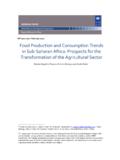Transcription of FRAMEWORK FOR LINKAGES BETWEEN HEAL TH, …
1 105 Chapter 7. FRAMEWORK for LinkagesFRAMEWORK FOR LINKAGESBETWEEN HEALTH, ENVIRONMENTAND DEVELOPMENT7In this chapter, a FRAMEWORK for considering LINKAGES BETWEEN health,environment and development issues is given. The FRAMEWORK isparticularly useful for describing pollution-related health impacts, butcan be applied in other contexts as well. Indicators at various levels inthe FRAMEWORK could be selected for use at the global, national and locallevels, in relation to particular problems, issues or policies and plans OF FRAMEWORKSD ecision-makers need not only better data on the LINKAGES BETWEEN the complexity offactors in the environment and development process affecting human health, but alsoenhanced understanding of such LINKAGES . In terms of sustainable development, aframework is needed in which the various environmental, economic and social factorsand components can be considered in a balanced way.
2 A FRAMEWORK for presentingthe LINKAGES among factors that affect health in the context of environment anddevelopment has been adapted from the pressure-state-response (P-S-R) modeldeveloped by OECD, which in turn was based on earlier work by the pressure-state-response (P-S-R) FRAMEWORK has been particularly useful inrepresenting the way in which pollution affects the environment, for example by lookingat the various pressures exerted on the environment which affect its state (quality)and consequently call for a response to deal with the situation. While this frameworkhas been criticized as being linear and uni-directional, an adaptation of the frameworkby the Commonwealth of Australia (93), indicating the feedback loops in circularfashion, has proven adaptations to the P-S-R FRAMEWORK have provided for the broader driving forcesand their impacts, resulting in the pressure-state-impact-response (P-S-I-R) FRAMEWORK , which takes into account human health, ecosystem and social-economicimpacts (94).
3 D-P-S-S-E-A FrameworkIn the context of human health impacts, both exposures and the resulting health effectsmust be represented. These aspects are taken into account in a further adaptation ofHealth in Sustainable Development Planning: The Role of Indicators106 Figure 18 PRESSURE-STATE-RESPONSE FRAMEWORKF igure 19 MODIFICATION OF THE PRESSURE-STATE-RESPONSE FRAMEWORKH uman subsystemeconomic subsystempopulation subsystempollutionresource depletionPRESSURE natural feedbacksRESPONSE social responsehuman system feedbackgoods & serviceslaborEnvironmental subsystemenvironmentalcompartmentsSTATE ecosystemsimpactsimpacts Source: World Resources Institute (29) Source: Commonwealth of Australia (93)HUMAN ACTIVITIES AND IMPACTSE nergyTransportIndustryAgricultureFisheri esOthersPRESSURESTATESTATE OR CONDITION OF THE ENVIRONMENT Air Water Land Resources BiodiversityHuman SettlementsCulture and HeritageINSTITUTIONAL AND INDIVIDUAL RESPONSESL egislationEconomic instrumentsNew TechnologiesChanging community valuesInternational obligationsOthersRESPONSEI nformationInformationResourcesPressuresS ocietal responses(decisions-actions)Societal responses(decisions-actions)107 Chapter 7.
4 FRAMEWORK for Linkagesthe FRAMEWORK for health purposes, referred to as the D-P-S-S-E-A FRAMEWORK (drivingforces, pressures, state, exposures, health effects and actions), (22). This is adescriptive representation of the way in which various driving forces generatepressures that affect the state of the environment and ultimately human health, throughthe various exposure pathways by which people come into contact with D-P-S-E-E-A FRAMEWORK , like the P-S-R FRAMEWORK on which it is based, representsthe components in a linear fashion in order to represent the connections betweenfactors affecting health and the environment more clearly. In reality, the situation ismore complex however, as various interactions occur at different levels betweenvarious components. The different components of the D-P-S-E-E-A FRAMEWORK aregiven in the figure FRAMEWORK takes account of the fact that, as already mentioned in Chapter 1,various factors responsible for health and environment problems may be associatedwith such driving forces as population growth, economic development, technologicalchange and to the policies underlying them.
5 Pressures may be exerted on theenvironment which cause development sectors to generate various types of outputs(for example in the form of pollutant emissions), causing the state (quality) of theenvironment to be degraded through the dispersal and accumulation of pollutants invarious environmental media, such as air, soil, water and food. People may become exposed to potential hazards in the environment when they come into direct contactwith these media, through breathing, drinking or eating. A variety of health effectsmay subsequently occur, ranging from minor, subclinical effects ( effects that haveFigure 20 PRESSURE-STATE-IMPACT-RESPONSE FRAMEWORKA mbient Environment:LandAirWaterP1P2Pn S1S2Sm I1 Human HealthI2 Ecosystem Health Economic andSocialI1 AestheticR1 Policy1 RkPolicykPn:Human activities Putting Pressure on EnvironmentSm:States ofAmbient EnvironmentQualityI1:Impact due to AmbientconsequencesRk: Response Policies Source: Harvard University (94)Health in Sustainable Development Planning: The Role of Indicators108not yet manifested in overt symptoms) to illness and death, depending on the intrinsicharmfulness of the pollutant, the severity and intensity of exposure and thesusceptibility of the individuals exposed.
6 The elderly, the young and the sick mayoften be more susceptible than other actions can be implemented at different points of the FRAMEWORK and may takea variety of forms, including policy development, standard setting, technical controlmeasures, health education or treatment of people with following sections give lists of indicators that could be used at various levels ofthe organizing FRAMEWORK , and which can be applied to information gathering andindicator development at the national or sectoral level, at the community orneighbourhood level or even at the level of an industrial enterprise (23). The frameworkis not rigid, and its applicability and usefulness will depend on the context in which itis many cases, consideration is given to more than one type of indicator for a similarissue, in order to illustrate the range of possibilities. The lists are not exhaustive butare meant to serve as a guide and stimulus for the selection of indicators that may beFigure 21D-P-S-E-E-A FRAMEWORK (DRIVING FORCES, PRESSURES, STATE,EXPOSURES, HEALTH EFFECTS AND ACTIONS) Source: WHO (7)ActionEffectExposureStatePressureDriv ingForcePopulationgrowthEconomic developmentTechnologyProductionConsumpti onWaste releaseNatural hazardsResource availabilityPollutionlevelsExternal exposureAbsorbeddoseTargetorgan doseMorbidityWell-beingMortality109 Chapter 7.
7 FRAMEWORK for Linkagesappropriate for use in particular situations. Specific measurement variables and unitsof measurement will have to be further specified in almost all cases (see Chapter 4).Here, the indicators are given in shorthand in order to highlight issues. Whenappropriate and relevant, indicators should be disaggregated by sex, in order toaddress the gender dimension, and by other variables indicative of FORCESAs already noted, a number of key factors on the macro scale broadly affect theenvironmental processes that may ultimately affect human health. For example,macroeconomic policies may have major effects on the environment and on people shealth. Trade and fiscal policies may indirectly impact on human health by affectingincome levels and distribution, and agricultural or energy policy may affect health byimpacting on land, air and water resources (95).
8 It is often at this level of decision-making, higher up in the FRAMEWORK , that indicators are useful for setting andevaluating policies, as they allow examination of the root causes of problems, even ifthese are seemingly remote from the issue under consideration. Thus, if the aim is totake effective action at source, indicators that allow tracing of health effects to theirunderlying cause can be useful and can give an early warning of pendingenvironmental problems. Waiting for actual health effects to occur may delay action,sometimes for reason for using indicators at this level is that a certain amount of informationis often available, whereas the necessary information becomes progressively moredifficult to acquire as one moves down the FRAMEWORK . Information is usually morereadily available on social and economic trends than, for example, on environmentalconditions and health effects, but the links BETWEEN environmental hazards and healtheffects become weaker and less direct as one moves higher up the of indicators associated with driving forces which might be of use at thislevel of the development-environment-health FRAMEWORK are given 12 EXAMPLES OF DRIVING FORCE INDICATORS Total fertility rate Population growth rate Urban growth rate Annual energy consumption levels GDP per capita and growth rate Income levels, distribution/trends Adult literacy rate Primary and secondary school enrolment rates Employment rate(cont d)Health in Sustainable Development Planning.
9 The Role of Indicators110 Population below poverty line Social equity various driving forces considered above may result in pressures on theenvironment. Many factors however, including policy context, social attitudes andeconomic infrastructure, affect the extent to which driving forces are translated intoactual pressures on the environment. Pressures are generated by all sectors ofeconomic activity, such as transport, energy, housing, agriculture, industry, tourismand so forth. Pressures can occur from resource extraction, processing of materialsand the production, distribution, consumption and release of waste products. Animportant pressure from the point of view of human health is the release of pollutantsinto the environment. Many different sources and media such as water, air and soilmay be discussed above, health and environment indicators at this level of the frameworkare important for addressing the root causes of problems, such as the release ofpollutants or wastes or certain infrastructural developments which may manifestthemselves only much later as effects on the state of the environment.
10 Nevertheless,constraints similar to those discussed above with respect to driving forces also operateat this level: for example, the ability of the environment to absorb the various stressesimposed on it influences the extent to which changes in the state of the 13 EXAMPLES OF INDICATORS ASSOCIATED WITH VARIOUS PRESSURES Pressure indicators: Air Number and type of polluting industries Levels of domestic consumption of gas, coal and biomass Production and consumption of ozone-depleting substances such aschlorofluorocarbons (CFCs) Consumption levels of leaded gasoline Average road traffic volume and density Annual emissions of:sulfur and nitrogen oxidesparticulates, toxics and heavy metalscarbon monoxide and volatile organic compounds (VOCs) Annual national and global emissions of greenhouse gases (for example carbondioxide) by source Annual emissions from major industrial facilities by source(cont d)111 Chapter 7.














